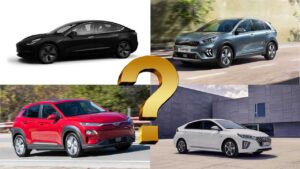Electric vehicles are gaining traction amongst consumers, no doubt, but before we see mass adoption there is one concern I have that hasn’t been properly addressed. Beyond high prices, limited range and poor charging infrastructure, a critical reason that I see why the shift to electric vehicles (EVs) will take longer is that people want bigger and therefore heavier cars. And crazily, it’s not just SUVs I’m talking about. More on this in a bit…
The difficulty for auto manufacturers is building SUVs with batteries that provide acceptable range. Simple science shows us that the heavier a vehicle is the more power is required to move it. Battery technology certainly exists to propel heavier vehicles, but range becomes completely compromised. As such, it’s no surprise that the majority of new EVs coming to our forecourts are smaller in size – be it the new e-Mini, the Honda e, or the VW ID. Yes, we do have examples of pure EVs in SUV style but these are mainly in the smaller crossover SUV category such as the Kia Nero EV, Hyundai Kona EV or MG ZS EV. Full size SUVs have certainly become more widely available in Hybrid form (ie both electric and combustion engines working in tandem) but finding yourself a full size pure-electric SUV is tough. The £72k Audi e-Tron might fit the bill (although at that price point likely not for most!) while the £65k Jaguar iPace has limitations in size, range, and charging capabilities. Meanwhile across the pond, GM recently made an announcement regarding the roll-out of full size all electric SUVs and pickups with ~600 mile ranges. Alas GM have been coming out with these kinds of proclamations for a few years now. This to say, I’m not holding my breath for GM to change the EV landscape anytime soon.
One can counter that battery technology is improving all the time and, by extension, full size all electric SUVs will become more readily available. But are batteries (and their ranges) improving? I’m not so sure. In fact, battery ranges in EVs have hardly improved since Tesla first made their mark with a pure electric sedan back in 2012. Let’s look at some examples to support this: Tesla’s first Model S released in 2012 was equipped with a 60kWh battery providing about 200 miles of range. By comparison, the crossover MG ZS EV that is available for purchase today is equipped with a 44.5kWh battery. This gives a supposed range of 145miles on a full charge. Meanwhile both the Kia and Hyundai all electric EVs are equipped with 64kWh batteries giving a realistic range of 225 miles. Eight years after Tesla released their first EV, competitors are releasing cars that are equipped with similar-sized batteries (or smaller!) offering similar range (or less!). This isn’t exactly an improvement. And while it is fact that Tesla now has 100kWh batteries giving an alleged 350 miles of range, these are in vehicles that have base prices of £92k, ie expensive and not viable for the masses.
Annoyingly for environmentalists and policy makers, consumers in the US have now shifted their focus from luxurious SUVs to luxurious… pickup trucks! Yep, GMC, Ford and RAM (Chrysler) – the big three US pickup truck manufacturers – are starting to see an uptick in demand from those wanting the flexibility of load-lugging without compromising on comfort. Leather interiors, wood grained dash, heated seats, 12inch touchscreens and all the associated tech are now available in vehicles originally designed for farm use.
So what does all this mean? Unless consumers can change their “bigger is better” mindsets, car manufacturers will need to produce electric SUVs (and pickup trucks!) that have ranges of 500 miles at prices of around £25k. If not, the move to an all-electric society might never happen. In the meantime, EVs risk being categorised as a second car for the upper classes with the likelihood that their other car is a heavily polluting SUV… Ouch.




